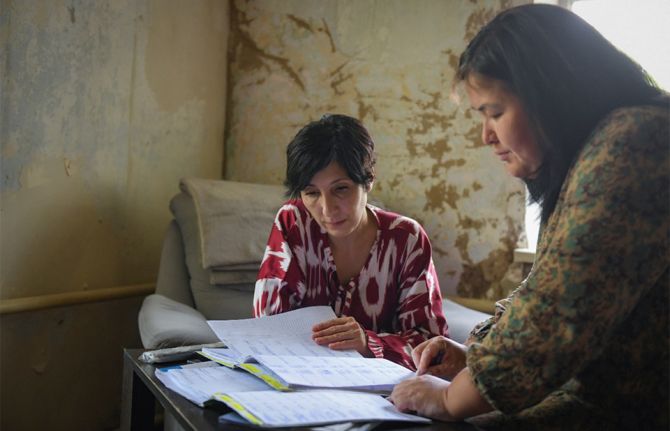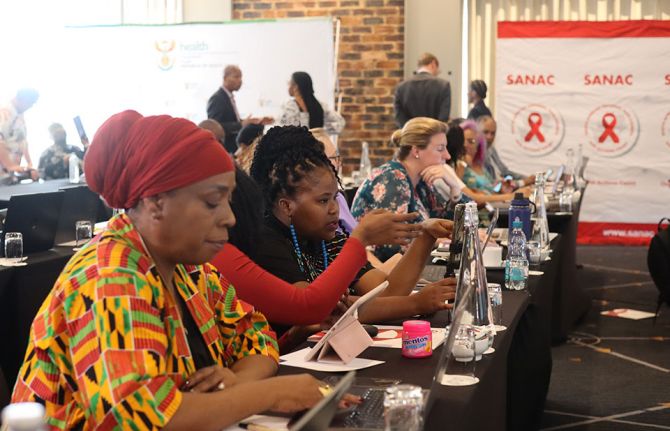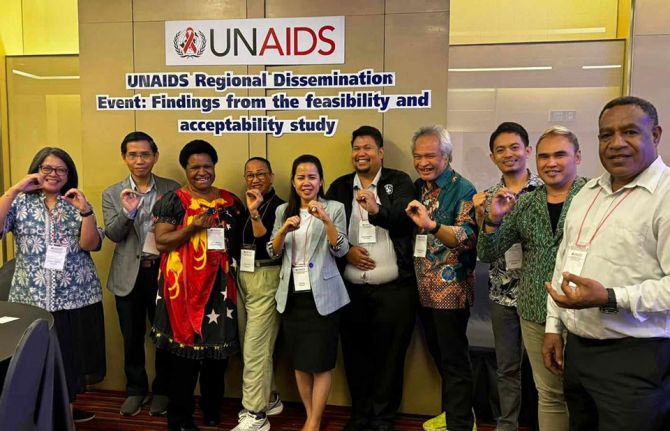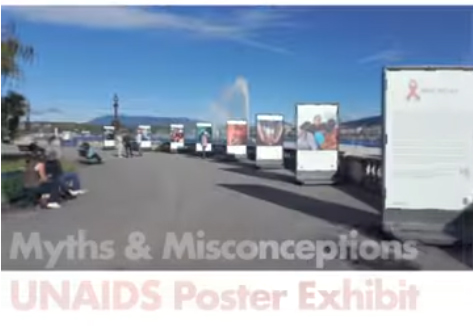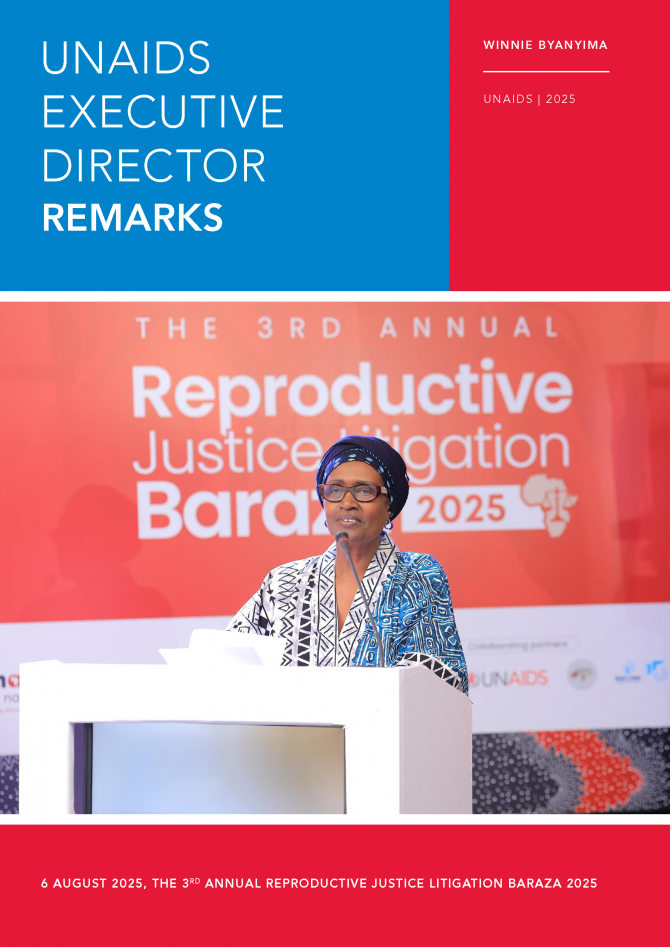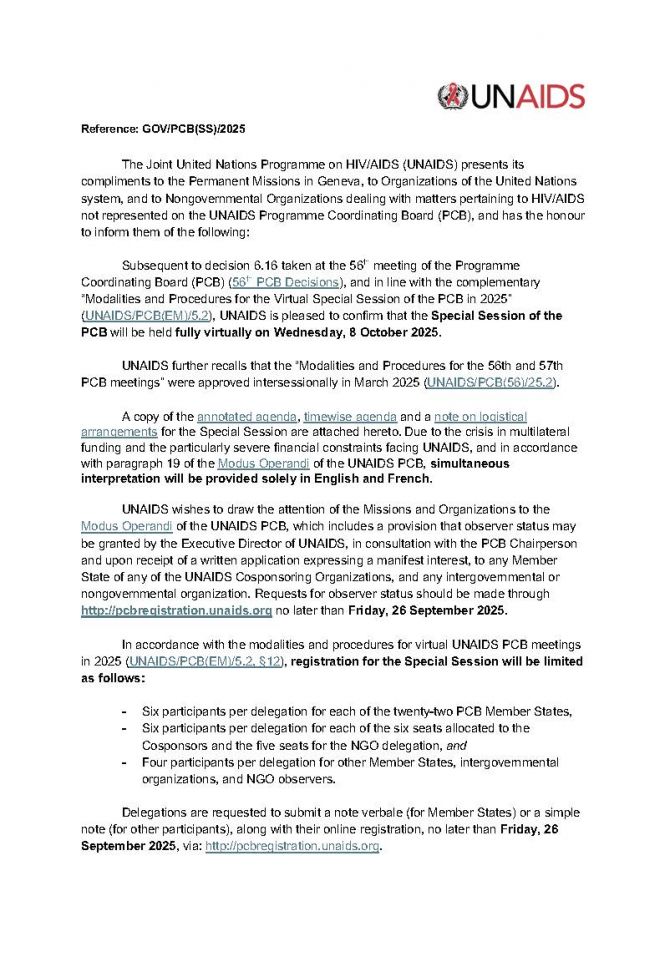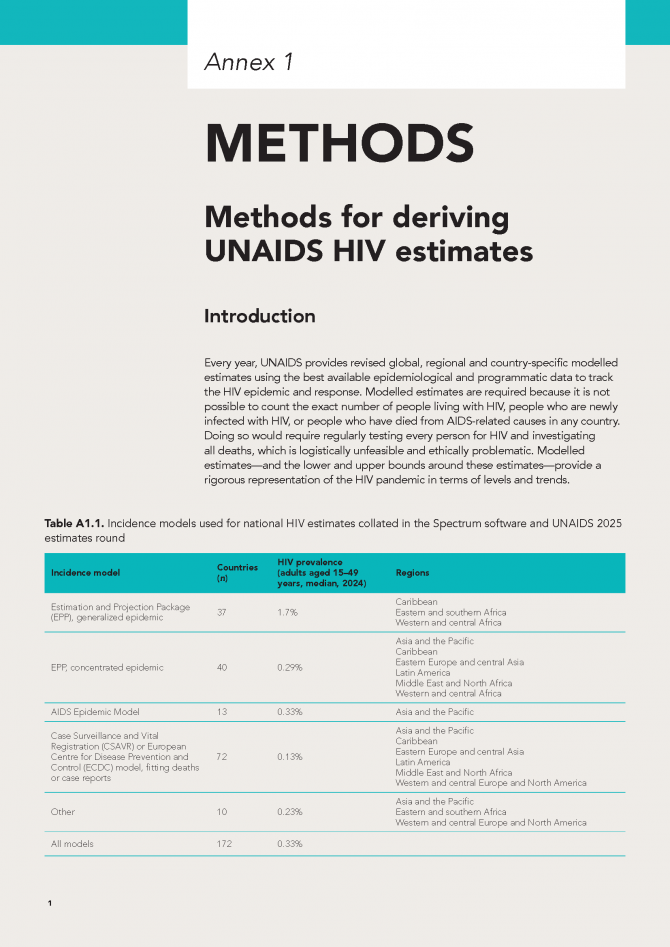Documents
Summary - System-wide evaluation on progress towards a "new generation of United Nations country teams"
12 September 2025
Documents
System-wide evaluation on progress towards a "new generation of United Nations country teams"
12 September 2025
This evaluation examined progress towards a “new generation of United Nations country teams” mandated by A/ RES/72/279. It assessed the alignment/derivation of UNSDG entity programming from Cooperation Frameworks, and the (re)configuration of UNCTs. It covered the period 2019-2025, all UNSDG entities and the Resident Coordinator system (including the Development Coordination Office) at country, regional and global levels. Read summary report.

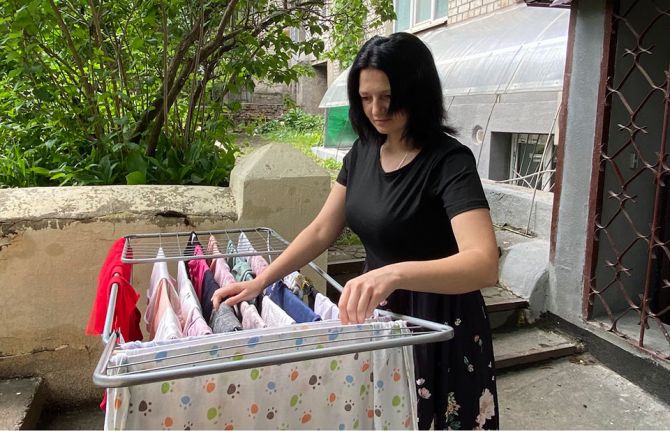


Feature Story
Women, HIV, and war: a triple burden
12 September 2025
12 September 2025 12 September 2025Lidiia comes from the Zaporizhzhia region, just steps away from Ukraine’s front line. After the full-scale invasion in 2022, her village fell under occupation. She lived in uncertainty for several long months.
“Staying there was unbearable — especially for women. It was constant fear — a nightmare,” she said. “The humanitarian situation was dire: aid vehicles couldn’t reach us, and some were simply shot at.”
Cut off from humanitarian assistance, Lidiia struggled to find basic supplies — food and hygiene products for herself and her young daughter. Most critical for her was not knowing where she could get her supply of antiretroviral therapy for HIV. People living with HIV take a daily pill to keep the virus at bay.
When medicine shortages reached a critical point, she fled her village. Before the war, the road to the eastern city of Dnipro took just three hours; this time, it took three days. Lidiia carried her baby daughter in her arms while pregnant with her son. Exhausted, she had no clear destination.
After days of uncertainty they reached Dnipro, where they found shelter run by the community-based organization “100% Life. Dnipro”. This safe haven welcomes primarily displaced people living with HIV or at high risk of infection, with a special focus on women and mothers with children. The shelters opened as part of the UNAIDS Emergency Fund 2022-2024 thanks to donor support. This shelter is among three in the Dnipropetrovsk region. They offer housing, food, hygiene products, and access to antenatal, pediatric, and HIV care. For mothers like Lidiia, it is not just shelter — it is a lifeline.
“I’m grateful we’re safe,” she said three years after arriving there. “But I still dream of going home — of walking through our front door again and knowing the war is over.”
According to UNHCR, 3.7 million people remain internally displaced within Ukraine, while another 6.9 million have sought refuge abroad. A large proportion are women and children, including many living with HIV and other vulnerable groups. Community-led research by community organisation, “Positive Women”, supported by UNAIDS and UN Women, surveyed 320 women living with HIV across Ukraine in late 2023–early 2024. It confirmed that women living with HIV are facing a triple burden: displacement, gender-based violence, and barriers in access to essential health services.
More than 70% of respondents reported worsening household economic well-being, and over a third lost property. One in six lost their jobs or businesses. Many women described being unable to meet even the most basic needs for themselves and their children. Barriers to health care have also increased as the war drags on. A third of women reported greater difficulties in reaching HIV services due to destroyed infrastructure, insecurity, or lack of resources. Women also reported high levels of anxiety, depression, and post-traumatic stress, compounded by caregiving responsibilities and separation from family.
Despite this, most managed to continue their life-saving medicine thanks to emergency distribution and community support.
For many this is a testament to the resilience of Ukraine’s health system and its civil society.
“The resilience of women like Lidiia, together with the findings of community-led research, highlight both the urgency and the possibility of action,” said Gabriela Ionascu, UNAIDS Country Director for Ukraine.“With sustained international support, community engagement, and rights-based approaches, access to vital services can be preserved—even in the most challenging of times.”
Region/country


Feature Story
Lower prices needed for new HIV prevention medicine in Brazil
09 September 2025
09 September 2025 09 September 2025Civil society representatives are demanding an urgent price reduction for long-acting injectable HIV medicines which prevent HIV.
During a public hearing at the Chamber of Deputies in Brazil, representatives called for strategies to expand access to innovative injectable HIV medications, including lenacapavir and cabotegravir, which have demonstrated more than 95% efficacy in preventing HIV infection.
The discussion was organized by The Committee on Human Rights, Minorities, and Racial Equality and brought together representatives of pharmaceutical companies, the government, and civil society.
“We are talking about rights,” stated Congresswoman Erika Kokay. “It is not a consumer relationship, it is a relationship of human rights and health that allows the population to take ownership of their own research. We are talking about a country where more than 10,000 people die every year due to AIDS-related illnesses.”
Despite Brazil being one of the countries which participated in the lenacapavir clinical trials (together with Argentina, Mexico, and Peru) it has been excluded from the list of countries that have received a licence to produce its generic version.
“Brazil was excluded from the licence because it is considered a middle-income country, which does not reflect the intense inequalities that exist in Brazil,” pointed out Susana Van der Ploeg, coordinator of Working Group on Intellectual Property. “In 2022, 23% of new HIV infections occurred in countries that were excluded from the licence, including countries that participated in clinical studies,” she added.
According to UNAIDS, Latin America is one of three regions in the world where the annual number of new HIV infections has increased, representing 13% of all new HIV infections between 2010 and 2024.
“When an innovation can save people’s lives but does not reach the people who need it, can we really consider it an innovation?” said Luciana de Melo, HIV/AIDS Coordinator at the Ministry of Health. “Price is a key issue in the incorporation of medicines to the country’s health system”
Cabotegravir, registered by ViiV Healthcare, is an injection administered once every two months to prevent HIV. The drug was approved by the Brazilian Health Surveillance Agency (ANVISA) in 2023 and launched on the Brazilian private market in August 2025. Currently, its average cost is R$ 4,000 per dose (U$ 740), around 2,5 times the minimum wage in Brazil. According to Brazilian Institute of Geography and Statistics, 31.8% of the population lived on an income between one and three minimum wages in 2023. There is still no date for the drug to be offered through Brazilian health system.
Lenacapavir, from the pharmaceutical company Gilead, is administered once every six months and is in the process of being registered for use in HIV prevention. Gilead has not yet announced the price of the drug to be used for HIV prevention in Brazil but its cost in the United States for treatment was recorded at over US$ 28,000 per person per year.
An article published in The Lancet magazine presents a different perspective for the generic version. The study projects that the cost of generic lenacapavir could range from as low as US$ 35 to US$ 46 per person per year. In addition, growth in demand could reduce this amount to US$ 25 per person per year if there were a committed demand of five to ten million people.
“We will not be able to reach our goals if we do not view access to health as a human right,” said Andrea Boccardi Vidarte, UNAIDS Country Director, Brazil.
Watch the full hearing (in Portuguese): https://www.youtube.com/watch?v=bcBecwT-WzY
Watch the full hearing (in Portuguese)
Region/country

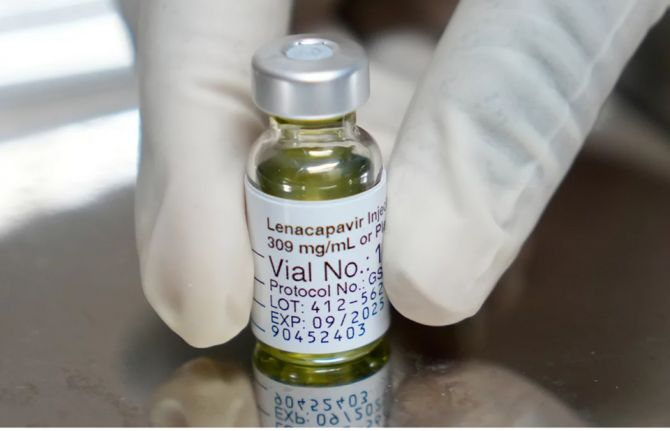
Press Release
UNAIDS welcomes US announcement to expand access to medicine to prevent HIV and urges greater global ambition to reach all in need
05 September 2025 05 September 2025GENEVA, 5 September 2025—UNAIDS welcomes the announcement by the US State Department that the President’s Emergency Plan for AIDS Relief (PEPFAR) will be supporting an initiative by the Global Fund to Fight AIDS, TB and Malaria to provide lenacapavir to up to 2 million people in countries with high burdens of HIV.
Lenacapavir, an American-based innovation, is one of the most promising new HIV prevention tools that has emerged in the HIV response, offering protection against HIV with just twice-yearly injections. The breakthrough medicine will save thousands of lives if made widely available for all people and populations at risk of HIV including young women and adolescent girls as well as sex workers, people who inject drugs, and men who have sex with men in high burden countries and geographies.
"This deal offers hope that many more people around the world who are at risk of HIV will have access to this revolutionary HIV medicine. More global work will be needed to increase scale and rapidly make lenacapavir available, affordable and accessible in all low and middle-income countries. But at this critical moment, the United States’ backing of this breakthrough medicine is an important signal to the world that by investing in the HIV response we can stop new infections,” said Winnie Byanyima, Executive Director of UNAIDS.
An initial roll-out of 2 million is an important start toward a broader ambition and i t is important that lenacapavir be available to all people in need, not only to some. UNAIDS estimates that 20 million people will need to be reached with antiretroviral-based prevention such as lenacapavir as part of efforts to achieve the 2030 global HIV prevention targets. UNAIDS also estimates that for every US$ 1 invested in HIV prevention, US$ 7 will be saved in treatment and care costs later.
The price for lenacapavir in France, Norway, Spain and the United States in late 2024 exceeded US$ 28 000 per person per year. For this initiative, manufacturer Gilead has pledged to supply the medicine at no profit. Research published earlier this year showed that lenacapavir can be made and sold for just US$ 40 per person per year, falling to US$ 25 with sufficient scale.
To successfully expand access to lenacapavir, community engagement will be essential. To advance progress in the roll-out, populations most impacted by HIV must play a central role in its delivery and people most at risk of HIV must have access.
UNAIDS will continue to support countries and partners in driving the response to HIV forward to ensure that everyone, everywhere has access to the HIV services they need and that AIDS is ended as a public health threat by 2030.
UNAIDS
The Joint United Nations Programme on HIV/AIDS (UNAIDS) leads and inspires the world to achieve its shared vision of zero new HIV infections, zero discrimination and zero AIDS-related deaths. UNAIDS unites the efforts of 11 UN organizations—UNHCR, UNICEF, WFP, UNDP, UNFPA, UNODC, UN Women, ILO, UNESCO, WHO and the World Bank—and works closely with global and national partners towards ending the AIDS epidemic by 2030 as part of the Sustainable Development Goals. Learn more at unaids.org and connect with us on Facebook, Twitter, Instagram and YouTube.

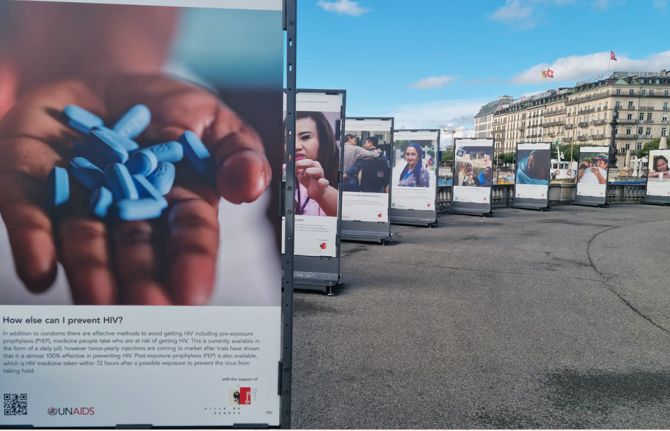
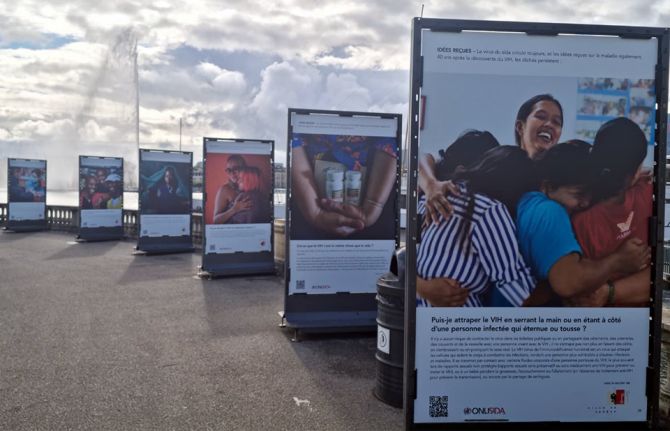

Press Release
UNAIDS exhibits posters in Geneva to dispel myths and misconceptions about HIV
02 September 2025 02 September 2025GENEVA, 2 September 2025—From 1 to 30 September, a series of UNAIDS posters is on exhibit in Geneva along the Lac Leman. The posters dispel many of the mistruths about HIV and AIDS. While many people think they may be well-informed about the virus, in reality many misconceptions continue to circulate. Forty years after the first cases of HIV were identified, misinformation, stigma and discrimination still persist. Worse still, the information gap is widening, particularly among young people who are often most affected by HIV.
“Today, people often find themselves drowning in information, but many are still not necessarily better informed about HIV,” said Christine Stegling, UNAIDS Deputy Executive Director. “This exhibit is designed to enlighten viewers about the current realities of HIV in the hope that they will learn how to protect themselves and be willing to support people living with HIV with more compassion.”
In 2024, UNAIDS estimates that there were 1.3 million new HIV infections - that’s 3 500 people newly infected with the virus every day. And although more than three quarters of the 40.8 million people living with HIV are on treatment, every minute, a person died of AIDS-related causes in 2024. In addition, people living with HIV still experience stigma and discrimination which prevents them from accessing HIV services. This includes treatment which stops transmission of the virus and keeps people alive and well. By knowing the facts and dispelling the myths, we can help break down the stigma and ensure that everyone feels safe to access HIV services, free from discrimination.
“HIV is preventable and, with treatment, people living with HIV stay healthy and cannot transmit the virus yet new infections still occur,” said Professor Alexandra Calmy, head of the infectious disease HIV unit at Hôpital de Genève (HUG.) “Campaigns like this remain essential, here and everywhere, to raise awareness and fight stigma.”
UNAIDS, the Joint United Nations Programme on HIV/AIDS, has put together this exhibition to dispel some of the myths around HIV and encourage people to know the facts, get tested and protect themselves against HIV.
"Sadly, there are still cases of discrimination against people living with HIV in Geneva and Switzerland," said Rocco Senatore, Director of the People living with HIV (PVA) network. “Many still ignore some of the basic facts about HIV thus the importance of such awareness campaigns."
The poster exhibit supported by the Ville de Genève will run until the end of the month in Geneva at the Rotonde du Mont-Blanc.
UNAIDS
The Joint United Nations Programme on HIV/AIDS (UNAIDS) leads and inspires the world to achieve its shared vision of zero new HIV infections, zero discrimination and zero AIDS-related deaths. UNAIDS unites the efforts of 11 UN organizations—UNHCR, UNICEF, WFP, UNDP, UNFPA, UNODC, UN Women, ILO, UNESCO, WHO and the World Bank—and works closely with global and national partners towards ending the AIDS epidemic by 2030 as part of the Sustainable Development Goals. Learn more at unaids.org and connect with us on Facebook, Twitter, Instagram and YouTube.


Feature Story
Displacement and HIV: doubly vulnerable in Ukraine
11 August 2025
11 August 2025 11 August 2025This story first appeared in the UNAIDS Global AIDS Update 2025 report.
In early 2022, shortly after the full-scale invasion of eastern Ukraine, Kateryna was pregnant and caring for her young son and daughter.
“We lived under constant shelling in Pokrovsk. For the sake of my children, I had to flee to give birth,” she says. She is originally from the Donetsk region in Ukraine, which by 2024 became the scene of intense fighting.
Today, her hometown of Pokrovsk lies in ruins. With three children and no home to return to, Kateryna is trying to rebuild her life from scratch.
Kateryna has found refuge in the city of Dnipro at a shelter run by the non-governmental organization 100% Life was established by UNAIDS with donor support. The shelter provides a safe environment for women living with HIV, including those with children. It is one of four such shelters in the Dnipropetrovsk region, offering vital humanitarian assistance and connections to HIV care for people who have lost everything.
Since the beginning of the war, nearly 3.7 million people have been displaced within Ukraine. As the violence has escalated and people are forced to flee repeatedly, many people are living in areas of active fighting or under occupation. In this context, any reliable assessment of the rate of HIV among displaced people is impossible.
Despite this, the health system in Ukraine, supported by humanitarian organizations and international donors, has made extraordinary efforts to ensure continued access to HIV treatment. From the first days of the invasion, the Public Health Center quickly distributed antiretroviral medicines to central and western regions, where most internally displaced people fled. Emergency stocks were concentrated in leading health facilities and, with the help of nongovernmental organizations, volunteers and partners, supply chains were rapidly restored.
“In the early days of the war, hospitals in Lviv were overcrowded,” says Olenka Pavlyshyn, an infectious diseases specialist at the Center for Integrated Medical and Social Services. “But even then, there were no interruptions in antiretroviral therapy.” People received three- or six-month supplies of medicines, and treatment was provided based on medical need rather than documents or place of residence.
The response also reached people who fled abroad. A total of 6.4 million Ukrainians have left the country, and many face barriers to health care in host countries. “In some European countries, our citizens still cannot get health insurance, so they have no access to medical care,” says Olenka. “Others are not ready to disclose their HIV status in a new environment, so these people come back to Ukraine every six months—and we give them the medicines they need for continued treatment while living abroad.”
As the health system in Ukraine adapts to the demands of a displaced population inside the country and beyond its borders, pressure is growing.
Ukraine was once a regional leader in transitioning from donor to domestic funding for health services, but its HIV resources are extremely constrained due to the war. The country now relies heavily on international assistance to sustain essential medical care, including HIV services. Although antiretroviral therapy has been secured, HIV services may be at risk due to cuts in United States funding.
New HIV infections and AIDS-related deaths could rebound globally if the funding cuts are not recovered. Continued international support is critical to sustain the HIV response and ensure countless people caught in a war, like Kateryna, are not left behind.



